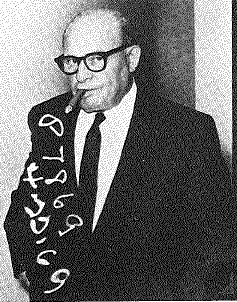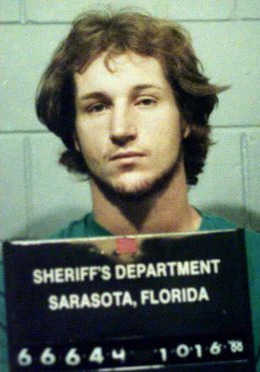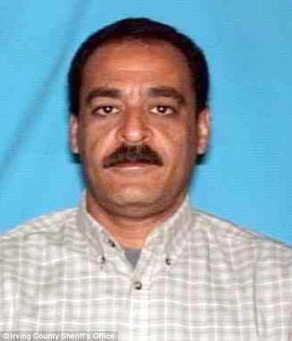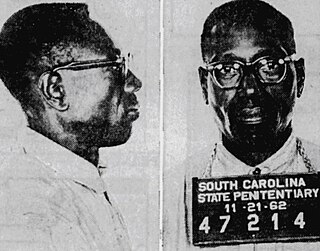
The Saint Valentine's Day Massacre was the murder of seven members and associates of Chicago's North Side Gang on Saint Valentine's Day 1929. The men were gathered at a Lincoln Park, Chicago garage on the morning of February 14, 1929. They were lined up against a wall and shot by four unknown assailants, two of whom were disguised as police officers.

Joseph Paul Franklin was an American serial killer, white supremacist, and domestic terrorist who engaged in a murder spree spanning the late 1970s and early 1980s.

Donald Eugene Webb was an American career criminal wanted for attempted burglary and the murder of police chief Gregory Adams in the small town of Saxonburg, Pennsylvania on December 4, 1980. It was only the second murder in the town's nearly 150-year history; the first murder occurred in 1842.

Frank "Bomp" Bompensiero was a Sicilian-American mobster who was a longtime caporegime in the Los Angeles crime family. In 1956, with the death of boss Jack Dragna, Bompensiero was demoted to the rank of soldier by the new boss, Frank DeSimone. He was the older brother of associate Salvatore "Sam" Bompensiero. Bompensiero made a name for himself for the many killings he committed on the orders of his superiors. Jimmy Fratianno, a close associate, once said that Bompensiero "had buried more bones than could be found in the brontosaurus room of the Museum of Natural History."

Stephen Peter Morin was an American serial killer who was suspected of being responsible for at least forty murders of young girls and women and 7 men in the period from 1969 to 1981. Since Morin led a transient lifestyle and constantly moved around the country, the exact number of his victims is uncertain, but he is suspected of a total 48 violent crimes across the United States. In the early 1980s, he was pursued by the federal authorities. Morin had created multiple aliases. These names included Rich Clark, Robert Fred Generoso, Thomas David Hones, Ray Constantino, and Constatine. The court found Morin sane and sentenced him to death by lethal injection. In 1985, he was executed by Texas after waiving his appeals.
Gary Lee Sampson was an American bank robber and later spree killer who killed three people and was sentenced to death by a federal jury in Massachusetts.

Tommy Lynn Sells was an American serial killer. Though convicted of only one murder, for which he received the death penalty and was eventually executed, authorities believe he committed a total of 22 murders. Sells himself claimed on various occasions to have murdered over 70 people.
On August 10, 1999, at around 10:50 a.m. PT, American white supremacist Buford O. Furrow Jr. walked into the lobby of the North Valley Jewish Community Center in Granada Hills and opened fire with an Uzi sub machine gun, firing 70 bullets into the complex. The gunfire wounded five people: three children, a teenage counselor, and an office worker. Shortly thereafter, Furrow murdered a mail carrier, fled the state, and finally surrendered to authorities.

Hank Earl Carr was a convicted criminal who, on May 19, 1998, shot his girlfriend's four-year-old son with a rifle, was arrested, and then escaped from his handcuffs and killed two Tampa detectives and a Florida state trooper. Carr then barricaded himself in a convenience store and held a clerk hostage before committing suicide with a self-inflicted gunshot wound to the head.
Herbert "Fat Herbie" Blitzstein was an American mobster who was a loanshark, bookmaker, racketeer and lieutenant to Tony "The Ant" Spilotro and the Chicago Outfit in Las Vegas, Nevada.
Zane Michael Floyd is an American convicted mass murderer who at the age of 23 killed four people and injured a fifth in a supermarket in Las Vegas, Nevada, on June 3, 1999. After being convicted of the murders, Floyd was sentenced to death by a Clark County jury.

Lovelock Correctional Center (LCC) is a Nevada Department of Corrections prison in unincorporated Pershing County, Nevada, United States, near Lovelock.

Michael J. Coppola, also known as "Mikey Cigars", is an American mobster and captain in the Genovese crime family active in their New Jersey faction. He made national headlines when he went into hiding for 11 years to avoid a possible murder conviction. He should not be confused with Michael "Trigger Mike" Coppola (1900–1966), also a member of the Genovese family.

James Craig Anderson was a 47-year-old American man who was murdered in a hate crime in Jackson, Mississippi on June 26, 2011, by 18-year-old Deryl Dedmon of Brandon. At the time of his death, Anderson was working on the assembly line at the Nissan plant in Canton, and raising an adopted son with his partner.

Frank John Cullotta was an American mobster in the Chicago Outfit and a member of the Hole in the Wall Gang burglary ring in Las Vegas with friend and mobster Tony Spilotro. After his arrest in 1982, he became a government witness and entered the witness protection program. Cullotta later became an author and a tour guide.

Yaser Abdel Said is an American convicted murderer. For 12 years, Said evaded arrest for the January 1, 2008, fatal shootings of his two daughters, whose bodies were found in his abandoned taxi cab in Irving, Texas. Said went into hiding after the killings. He remained a fugitive from law enforcement for 12 years, and for six of those years was on the FBI Ten Most Wanted Fugitives List.

Leon David Dorsey IV was an American serial killer who was executed in 2008 for the murders of two Blockbuster store employees. Dorsey murdered the two men and a Korean store clerk during a rampage in Texas in 1994. He confessed and was later given a death sentence. He was executed at the Huntsville Unit on August 12, 2008.

Monroe Hickson was an American serial killer who confessed to killing four people in the city of Aiken, South Carolina over five months in 1946. Convicted and sentenced to four life terms, he managed to escape from prison and remained a fugitive for nearly two years. He was added to the FBI Ten Most Wanted Fugitives list in 1967 but was never recaptured, as he was found dead in North Carolina in 1968.

Nathaniel Burkett was an American serial killer. A native of Picayune, Mississippi, Burkett was convicted of killing his mother by intentionally setting her on fire in 1982, a crime for which he was sentenced to 20 years in prison. He was released early and moved to Las Vegas, where he was convicted of killing a woman he lured behind a church in 2002. In 2012, shortly after being released from prison for that crime, he was linked via DNA to three unsolved murders in Las Vegas, and for these crimes he was sentenced to life in prison in 2018.















